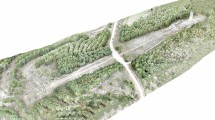The article considers the problem of improving the accuracy of digital terrain models created for monitoring and diagnostics of the railway track and the surrounding area. A technical solution to this problem is presented, which includes a method for joint aerial photography and laser scanning, as well as a method for digital processing of the obtained data. The relevance of using this solution is due to the existence of zones of weak reception of signals from the global navigation satellite system, since in these zones the accuracy of constructing digital terrain models using currently used diagnostic spatial scanning systems is reduced. The technical solution is based on the method of digital processing of aerial photographs of the railway track. In this case, the rail track lines located at a normalized distance from each other are used as external orientation elements. The use of this method made it possible to increase the accuracy of determining the flight path of an aircraft over railway tracks and, as a result, the accuracy of calculating the coordinates of points on the earth’s surface. As a result, a digital terrain model that is suitable for diagnosing and monitoring the state of the roadbed of a railway track was created. In simulation modeling, it was found that the application of the proposed method allowed reducing the confidence interval of the distribution of the error in determining the coordinates of points on the terrain to 50% and increasing the accuracy of forming a digital terrain model. This promising technical solution for improving the accuracy of digital terrain models for railway track diagnostics is implemented using unmanned aerial vehicles that are part of a mobile diagnostic complex. The advantages of the proposed solution include high efficiency and availability of application.





Similar content being viewed by others
References
E. B. Vasyukevich, “On the track section of the scientific and technical council,” Put’ Putev. Hoz., No. 3, 22–28 (2011).
S. N. Popov, Ballast Layer of the Railway Track, Transport, Moscow (1965).
A. A. Abrashitov, “Mechanism of splash formation in ballast prism section,” Mir Transp., 13, No. 3 (58), 210–217 (2015).
N. V. Nepomnyashchy and S. A. Kosenko, “Analysis of the behavior of a ballast layer of a railway track during longterm operation,” Tend. Razv. Nauki Obrazov., No. 43–8, 52–56 (2018), 10.18411/lj-10-2018-194.
V. L. Shapovalov, V. A. Yavna, K. M. Ermolov, et al., “Engineering solutions to improve the stability of the railway upper structure,” Vestn. Rostov. Gos. Univ. Putei Soobsh., No. 4 (68), 119–135 (2017).
I. K. Mikhalkin, O. B. Simakov, and Yu. A. Sedelkin, “Automated means of ballast prism and roadbed monitoring in the infrastructure complex diagnostics system,” Put’ Putev. Hoz., No. 5, 16–18 (2011).
V. M. Bugaenko, “Monitoring and diagnostics of infrastructure by high-speed mobile complexes,” Put’ Putev. Hoz., No. 4, 12–16 (2015).
I. K. Mikhalkin and Yu. A. Sedelkin, “Diagnostic complex SMDL-2TE116: a new approach to diagnostics,” Vestn. Inst. Probl. Estestv. Monopol.: Tekhn. Zhelezn. Dorog, No. 1 (33), 64–67 (2016).
F. E. Idachaba, Oil Gas Facil., 5, No. 1, 47–52 (2016), https://doi.org/10.2118/172471-PA.
J. Ondráček, O. Vaněk, and M. Pěchouček, Advances in Practical Applications of Heterogeneous Multi-Agent Systems. The PAAMS Collection. 12th Int. Conf., Salamanca, Spain, June 4–6, 2014, Lecture Notes in Computer Science (2014), Vol. 8473, pp. 219–230, https://doi.org/10.1007/978-3-319-07551-8_19.
S. A. Kadnichanskiy, M. V. Kurkov, V. M. Kurkov, and A. G. Chibunichev, “Certification testing hardware-and-software complex based on unmanned aerial vehicle Geoscan 401,” Geodez. Kartograf., 81, No. 3, 32–38 (2020), https://doi.org/10.22389/0016-7126-2020-957-3-32-38.
P. A. Revel’-Muroz, S. N. Chuzhinov, A. N. Prokhorov, et al., Patent No. 2591875S1 RF, Izobret. Polezn. Modeli, No. 20 (2016).
I. N. Rosenberg, “Application of satellite and geoinformation technologies in railway equipment progress,” Byull. Ob’ed. Uchen. Soveta OAO RZhD, No. 5, 8–20 (2012).
V. M. Zhidov, “Substantiation of the integration of satellite and inertial measurements for the railway tracks photography,” Geodez. Kartograf., No. 11, 10–12 (2010).
V. I. Pavlov, Photogrammetry. Theory of a Single Shot and a Stereoscopic Pair of Shots, Sankt-Peterburg. Gornyi Institut im. Plekhanova, St. Petersburg (2006).
D. A. Roshchin, Patent No. 2726256S1 RF, Izobret. Polezn. Modeli, No. 19 (2020).
D. A. Roshchin, “Method of using computer vision to improve the accuracy of terrain aerial photography,” Prikl. Informat., No. 6, 58–70 (2017).
D. A. Roshchin, “Improving the accuracy of forming a three-dimensional terrain model,” Inform.-Izmer. Upravl. Sist., 17, No. 2, 46–52 (2019), https://doi.org/10.18127/j20700814-201902-04.
Author information
Authors and Affiliations
Corresponding author
Additional information
Translated from Izmeritel’naya Tekhnika, No. 2, pp. 22–29, February, 2021.
Rights and permissions
About this article
Cite this article
Roshchin, D.A. Improving the Accuracy of Forming a Digital Terrain Model Along a Railway Track. Meas Tech 64, 100–108 (2021). https://doi.org/10.1007/s11018-021-01903-7
Received:
Accepted:
Published:
Issue Date:
DOI: https://doi.org/10.1007/s11018-021-01903-7




